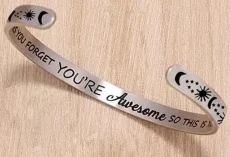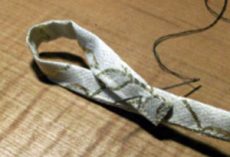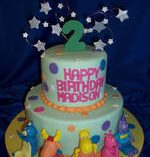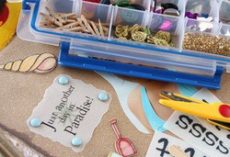I’m restoring a house from 1905, and as we worked on demolishing and removing what my husband calls “100 years of well-intentioned renovation,” I was excited to find some lovely hardwood floors underneath a few layers of old linoleum and glue. Luckily, the wood was largely in great shape — it just needed some sanding, and, in one room, some major scraping and sanding.
The kitchen had layers of old linoleum and glue on top of the original hardwood floors. I knew I needed some serious tools to expose those floors. I love that Home Depot has a Tool Rental department, and they had just the tools for the job. I found that there are different kinds of floor sanders — and choosing the right one is important. I’ll show you what sander I chose, why, and share some tips and tricks you’ll need to know — after the break!
As you can see in the preceding picture, the kitchen floor in the house was the worst. Once I scraped up the old linoleum layers, there was still some old backing paper and glue on top of the hardwood, and I knew that it was going to take more than a little effort to get it done. Before I even got started in the rental department, I stopped and picked up some of these:
I grabbed this kit because it had three essentials: a sanding mask, eye protection and ear protection. I’ve later found a style of mask I like even better — with a valved respirator (meaning it’s easier to breathe) — and that isn’t as hot (you can find it here).
You don’t want to breathe the sanding dust if you can help it. It’s just a bad idea to breathe a lot of sawdust to begin with, but it’s also possible that you might be allergic to something in the wood. Most frightening: some of the paints and adhesives used years ago may also contain asbestos, so it’s — again — better to be safe than sorry. Since I couldn’t identify exactly what it was on my wood floor — probably some old adhesive, possibly mastic, I felt it was best to be safe.
Once I had the safety supplies, I was off to the rental department.
The helpful gentlemen in my local Home Depot Tool Rental department asked me about the floors I was going to sand, and disabused me of the notion that I wanted to use a drum sander. I had thought I wanted to use one, but they pointed out my first important tip: unless I really knew how to use one, they are hard to control and likely to damage the floor. They suggested I was better off using a oscillating sander — so that’s exactly what I did.
Tip: Consider a oscillating sander to minimize damage to the floor, accidentally making lower and higher places in the floor, and to provide an overall more even finish.
They also had me pick up a variety of grits in the sanding pads. As you might imagine, it’s best to start with a coarser grit and work your way to a finer grit with each pass of the sander. I started with a very coarse grit — and went through a lot of pads — to remove the gunk from the floor; then moved to a finer grit for a semi-final pass.
Tip: Be sure to start with a coarser grit and move to a finer grit with each pass. This will give you a more even and smooth finish on the floor.
I picked up the full system, complete with a vacuum system I wore on a back harness. I had to empty the canister frequently to minimize the danger of fire. (The second time I rented the sander, the Home Depot folks recommended I just use my giant ShopVac, which I did.
As you can see from that day’s Instagram photo, I was ready to go and looked like a GhostBuster.
Rather than detail the “fun” I had getting all of the gunk off of this floor, I’ll simply say that it took most of a day to get that one room done with the thick coat of adhesive on top. The other two rooms I did went much faster and used up much fewer sanding pads because they didn’t have as many layers of gunk.
You can see that the random sander enabled me to go back over stubborn sections more than once without worrying about accidentally gouging or creating valleys in the floor.
Tip: You can use a mouse sander or other smaller hand sander to get particularly stubborn patches. Just don’t forget your mask!
Now, I’m not done yet. While we’ve done the major “gunk removal” process and gotten the floors nearly ready, we are still going to go over each of them with a handheld belt sander, with the grain and with a fine grit paper to help bring out the grain and make sure we’ve edged the room correctly.
Tip: Use a handheld belt sander with the grain, with a fine-grit sandpaper, as your final pass to help bring out the grain.
As a final pass, we’ll fill in any big gaps or gouges with stainable wood filler.
Finally, we’ll be putting down a nice dark stain — and we’ll probably have to custom-mix the stains for each room since the woods appear to be different in each.
We expect to use a nice stain and polyurethane, like the fine Minwax products sold at Home Depot. I’m going to put on multiple coats of the oil-based polyurethane to help give each floor a thick, protective, glossy finish.
And don’t forget — it might be worth considering just installing a new hardwood floor instead if your floor is overly damaged or irreparable.






